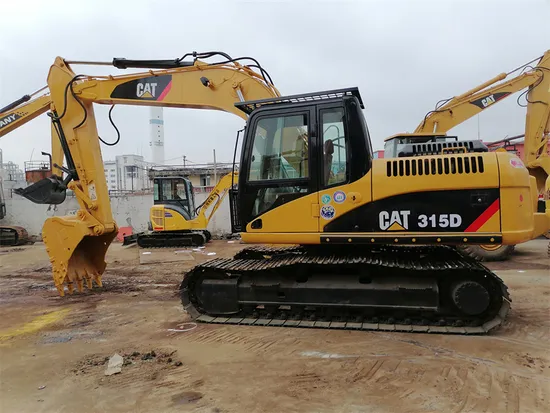The Sustainable Option: Perks of Acquiring Pre-owned Construction Machinery

In a world steadily focused on environmental preservation, the construction industry is achieving significant strides towards sustainable practices. One of the most impactful ways to contribute to this trend is by choosing used construction equipment. With escalating costs and ecological concerns, investing in second-hand machines has become a practical solution for many contractors and builders seeking to minimize their impact while enhancing their resources.

Purchasing used machinery not only aids cut down on waste but also prolongs the lifecycle of important equipment. Many high-quality second-hand options are available that can function just as well as newly manufactured counterparts, often at a fraction of the cost. As businesses aim to enhance their sustainability efforts, the advantages of opting for used construction equipment become ever more evident, making it a smart choice for the future.
Savings on Expenses
Buying second-hand construction machinery can lead to significant cost savings. New machinery often comes with a large price tag, which can burden budgets, especially for small to mid-level businesses. Selecting pre- https://www.yuyi-machine.com/ allows companies to acquire reliable machinery at a small percentage of the original cost. This economic benefit enables businesses to manage their resources more effectively, channeling resources in other essential areas such as staffing or project growth.
In addition of the reduced purchase price, used machines often come with lesser insurance costs. Because the value of second-hand equipment is generally less than that of brand new models, insurance premiums are broadly more affordable. This minimization in ongoing expenses contributes to overall savings, making used construction machinery an appealing option for budget-sensitive construction firms.
Moreover, buying used equipment can provide prompt access to high-quality brands that might otherwise be budgetarily out of reach. Many used machines are still in superb condition and can perform just as well as new ones. This access to premium brands without the new machine premium allows contractors to stay in the game while preserving their profitability.
Impact on the Environment
Purchasing second-hand construction equipment greatly reduces the demand for brand-new machinery. The creation of construction machines is materials-heavy, necessitating large amounts of raw materials and energy. By choosing used equipment, companies can assist in saving these valuable resources and lower the overall environmental footprint linked to production.
In addition, acquiring used machines supports a more circular economy in the construction industry. When used equipment is restored and reused, it extends the life cycle of the machinery, keeping it out of landfills and reducing waste. This practice not only lessen environmental impact but also encourages responsible consumption, as businesses become more aware of their resources and their influence on the planet.
Additionally, the transportation of new equipment adds to carbon emissions. Used construction machinery often has a smaller carbon footprint when factoring in the energy and materials saved by not producing new machines. By choosing used equipment, companies can lower their transportation emissions and contribute to reducing overall industry-related greenhouse gas emissions, thus creating a more sustainable future.
Reliability and Quality
When considering used construction machinery, reliability is a key factor that cannot be ignored. Many people assume that new equipment is inherently more reliable, but this is not always the truth. Used machines—especially those that have been well-maintained—can offer the same level of performance as new models. They often come with a proven track record, allowing buyers to assess their historical performance and maintenance records, which can lead to more informed purchasing decisions.
Excellence is another important aspect to evaluate when purchasing second-hand equipment. Many used machines are built to last, often featuring durable materials and sturdy construction methods that can withstand the rigors of intensive operation. Because construction equipment is designed for challenging work environments, many units that are sold again after only a few years show little wear and tear. This high-quality craftsmanship means that purchasing used machinery can be just as effective as investing in new options while avoiding the steep depreciation that comes with new purchases.
Moreover, buying used equipment can provide access to machinery that might otherwise be financially out of reach if bought new. This creates opportunities for businesses to acquire high-quality, reliable machines without stretching their budgets. By selecting properly cared for second-hand equipment, companies can enjoy excellent performance and durability while making a more eco-friendly choice for their construction needs.
Market Trends
This market for pre-owned construction equipment has undergone a considerable surge in recent years. Growing demand for budget-friendly and effective machinery has driven many contractors to pursue previously-owned equipment rather than acquiring latest models. This trend is largely influenced by the escalating costs of brand-new construction machinery, which can strain budgets, especially for small to medium-sized enterprises. As a result, the pre-owned machine market has emerged as a viable solution for companies striving to maintain their market position without compromising quality.
Additionally, the ongoing attention on sustainability has boosted the popularity of used construction equipment. As businesses and individuals alike prioritize environmental responsibility, purchasing second-hand machinery has surfaced an green choice. This practice not only reduces waste by extending the lifespan of prior machines but also minimizes the carbon footprint related to manufacturing fresh equipment. Many companies are now proactively advertising their used inventory as an sustainable option that fits with modern sustainability goals.
In conclusion, advancements in technology and equipment maintenance have boosted the attractiveness of buying second-hand machinery. Enhancements in the availability of reliable data regarding the history and performance of second-hand equipment allow buyers to make well-informed decisions. With thorough inspections and refurbishing options provided, contractors can identify machines that meet their needs while ensuring they are obtaining a reliable product. This transformation in market dynamics is probable to continue, with greater focus on the benefits of purchasing used machines in the construction industry.
